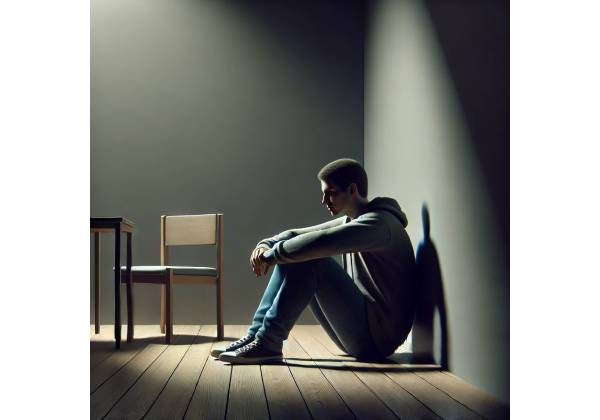What is Autophobia?
Autophobia, also called monophobia, is an anxiety disorder in which people have an intense, irrational fear of being alone or feeling isolated. While many people may feel uneasy when left alone, those with autophobia experience overwhelming panic at the prospect of being alone, even in safe environments such as their own homes. This fear is not limited to physical isolation; individuals with autophobia may experience severe distress if they believe they will be emotionally or socially isolated.
Autophobia is often caused by a deep concern about one’s own safety, the possibility of abandonment, or the overwhelming fear that something terrible will happen while alone. This phobia can cause significant disruptions in daily life, impacting personal relationships, work, and overall quality of life. It may also be associated with other anxiety disorders, such as agoraphobia or generalized anxiety disorder (GAD), exacerbating the situation.
While the exact cause of autophobia varies from person to person, it frequently stems from past traumatic experiences, abandonment issues, or an anxiety predisposition. Fortunately, autophobia is treatable, and individuals can control their symptoms with the right therapeutic interventions, coping strategies, and support systems. Understanding the symptoms, causes, and treatment options is critical for overcoming the crippling effects of this phobia.
What are the symptoms of autophobia?
Autophobia manifests itself as a wide range of symptoms affecting the mind, body, and behavior. For some people, these symptoms are mild, whereas for others, the fear of being alone causes severe reactions such as panic attacks and distress. The following is a thorough examination of the most common physical, cognitive, emotional, and behavioral symptoms of autophobia.
Physical Symptoms
When confronted with the fear of being alone, people with autophobia may exhibit a variety of physical symptoms that are frequently associated with increased anxiety. These symptoms can appear suddenly and worsen during periods of anticipated or actual isolation:
- Rapid Heart Rate: As anxiety increases, the individual’s heart may begin to race, which is a normal physiological response to fear and panic.
- Shortness of Breath: Difficulty breathing, or a feeling of not getting enough air, can accompany anxiety and panic attacks triggered by being alone.
- Trembling or Shaking: When the fear response kicks in, some people may notice their hands, legs, or entire body shaking.
- Chest Tightness: The sensation of pressure or tightness in the chest can be a frightening physical symptom that is frequently misdiagnosed as a cardiac issue but is actually caused by anxiety.
- Dizziness or Lightheadedness: Excessive fear can cause dizziness or lightheadedness, particularly during panic attacks.
- Sweating: Excessive sweating, especially in stressful situations such as isolation, is another common symptom.
- Nausea or Stomach Distress: The anxiety caused by the fear of being alone can result in gastrointestinal symptoms such as nausea or stomach cramps.
- Hot Flashes or Chills: Extreme anxiety can cause fluctuations in body temperature, such as feeling suddenly hot or cold.
Cognitive symptoms
Autophobia has a significant impact on cognition, influencing how people perceive their situation and interpret their thoughts when they are anticipating or experiencing isolation. The cognitive symptoms of autophobia are:
- Catastrophic Thinking: When left alone, those with autophobia frequently imagine the worst-case scenarios, such as the possibility of an intruder breaking in or an unexpected emergency occurring.
- Intrusive Thoughts: Persistent and unwanted thoughts related to fear of isolation can invade the mind, making it difficult to concentrate or focus on other tasks.
- Difficulty Concentrating: Anxiety about being alone frequently interferes with one’s ability to focus because the mind is preoccupied with the fear of being left alone.
- Obsessive Worrying: People with autophobia may spend a lot of time worrying about being abandoned or left alone, even when it is unlikely to happen.
- Dissociation: In severe cases, individuals may feel detached from reality or experience depersonalization, which occurs when they feel disconnected from their body or emotions as a result of fear.
Emotional Symptoms
Autophobia has a significant emotional impact, frequently causing deep feelings of distress and helplessness. These emotional symptoms can significantly impact an individual’s mental well-being.
- Intense Fear or Dread: The most prominent emotional symptom is a strong fear of being alone, which causes significant distress even when the individual is not currently isolated.
- Feelings of Abandonment: Autophobia can cause an irrational fear of abandonment, which is often based on previous experiences or the belief that others will abandon them permanently.
- Panic Attacks: In severe cases, the fear of being alone can cause full-blown panic attacks, which are characterized by a sudden surge of fear that lasts only a few minutes and is accompanied by debilitating physical symptoms.
- Hopelessness or Despair: Being unable to cope with isolation can lead to feelings of hopelessness, as people may feel trapped by their phobias.
- Irritability or Mood Swings: Increased anxiety and fear can cause mood swings or irritability, especially if the person is expecting to be left alone or is struggling to manage their emotions.
Behavioral Symptoms
The fear of being alone motivates many behavioral changes, including avoidance tactics and reliance on others. These behaviors can significantly disrupt a person’s day-to-day functioning and relationships.
- Isolation Avoidance: People with autophobia will go to great lengths to avoid being alone, often arranging their schedules or environments so that they are always surrounded by others.
- Constant Need for Reassurance: Many people with autophobia seek reassurance from family, friends, or partners that they will not be abandoned or left alone.
- Clinging Behavior: This can be defined as an excessive reliance on loved ones or a reluctance to let them go, even in safe or familiar surroundings.
- Overplanning: Autophobic people may overplan social interactions or outings to ensure they are not alone, sometimes overextending themselves socially to avoid isolation.
- Excessive Communication: When they are physically alone, people with autophobia may constantly call or message others to find comfort and reassurance that they are not emotionally alone.
Recognizing these symptoms early is critical for seeking assistance and beginning treatment. While the symptoms of autophobia can be overwhelming, they are treatable with a variety of therapeutic approaches, and early intervention can significantly improve quality of life.
Causes and Risk Factors For Autophobia
Autophobia can be caused by a combination of genetic, psychological, environmental, and situational factors. Understanding the underlying causes of this condition is critical for determining effective treatment options and addressing the fears that drive it.
Psychological and Emotional Factors
A significant number of people with autophobia have experienced past trauma or emotional distress due to feelings of abandonment or isolation:
- Abandonment Issues: Early experiences of abandonment, whether real or perceived, can instill a deep fear of being alone in adulthood. These experiences could result from the loss of a caregiver, a significant breakup, or feeling neglected during critical developmental stages.
- Child Trauma: Childhood experiences, such as being frequently left alone or feeling unsafe when separated from caregivers, can leave long-lasting emotional scars. These early fears of isolation can develop into full-blown autophobia in adults.
- Fear of Helplessness: For some people, autophobia is linked to a fear of helplessness, which is associated with being alone and being unable to respond to emergencies or protect oneself from potential threats.
Genetic and Biological Factors
Autophobia, like many other anxiety disorders, may be genetically determined. Individuals with a family history of anxiety, phobias, or panic disorders are more likely to develop such conditions:
- Genetic Predisposition: A family history of anxiety disorders increases the risk of developing autophobia. Genetic factors can influence how the brain processes fear and anxiety, making certain people more likely to develop phobias.
- Neurochemical Imbalances: Imbalances in neurotransmitters that regulate mood and emotional responses, such as serotonin and dopamine, can contribute to increased fear and anxiety in people suffering from autophobia.
Environmental Triggers
Certain environments or situations may aggravate feelings of fear and isolation in people with autophobia.
- Traumatic Life Events: Significant life changes, such as the death of a loved one, divorce, or relocation, can cause autophobia, especially if the individual feels abandoned or unsupported.
- Chronic Stress: Prolonged stress, whether from work, relationships, or other aspects of life, can increase feelings of anxiety, making people more likely to develop autophobia.
- Lack of Social Support: People who do not have a strong support network or who are socially isolated may be more likely to develop autophobia because they fear being completely alone with no one to rely on.
Risk Factors
In addition to these causes, the following risk factors can increase the likelihood of developing autophobia:
- Co-occurring Mental Health Disorders: People who have other anxiety disorders, depression, or agoraphobia are more likely to develop autophobia.
- Previous Phobia or Anxiety History: A history of other phobias or anxiety disorders can predispose someone to developing autophobia as their fear of isolation worsens over time.
Understanding the causes and risk factors of autophobia can assist individuals and mental health professionals in developing personalized treatment plans that address the phobia’s specific origins. It’s important to remember that, regardless of the cause, autophobia is a treatable condition, and with the right help, people can learn to manage their fears and regain control of their lives.
How Is Autophobia Diagnosed?
Autophobia is diagnosed after a thorough evaluation by a mental health professional, who will assess the phobia’s severity, impact on daily functioning, and any potential underlying psychological issues. Clinical interviews, psychological assessments, and, in some cases, differential diagnosis are commonly used to rule out other conditions.
Clinical Interviews
The initial step in diagnosing autophobia is typically a clinical interview with a psychologist or psychiatrist. During this session, the healthcare provider will inquire about the individual’s specific fear of being alone, including when it began and how it affects their daily life. They will also inquire about the individual’s history of anxiety, any previous traumas, and whether there is a family history of anxiety or phobic disorders.
Questions may focus on:
- An individual’s emotional and physical responses when alone or anticipating isolation.
- How the individual tries to avoid being alone, including any drastic measures taken to prevent isolation.
- The effect of fear on work, relationships, and social activities.
Psychological Assessments
Mental health professionals may use standardized tools and questionnaires to assess the severity of an individual’s anxiety and phobia. Common diagnostic tools for phobias and anxiety are:
- Fear Questionnaire: This scale assesses the level of fear in response to various phobic stimuli, including the fear of being alone.
- Beck Anxiety Inventory (BAI): The BAI evaluates the severity of general anxiety symptoms that may accompany or exacerbate autophobia.
- Panic Disorder Severity Scale (PDSS): For people who suffer from autophobia and have panic attacks, the PDSS can help assess the frequency and severity of these episodes.
These assessments help mental health professionals gain a better understanding of the individual’s emotional and psychological distress, allowing for a more accurate diagnosis and treatment plan.
Differential Diagnosis
It is critical to distinguish autophobia from other mental health disorders that may present with similar symptoms. A thorough evaluation ensures that the diagnosis is correct and that the patient receives the necessary treatment. Conditions that may need to be ruled out are:
- Agoraphobia: While both agoraphobia and autophobia involve the fear of being alone or in situations where escape is difficult, agoraphobia is more concerned with being in specific public places rather than the fear of isolation in general.
- Generalized Anxiety Disorder (GAD): People with GAD have persistent and excessive worry about a wide range of topics, including fears of being alone. However, autophobia is defined by the fear of isolation rather than a broader anxiety profile.
- Separation Anxiety Disorder: This condition, which is most common in children but can also affect adults, is characterized by intense fear and distress when separated from loved ones. However, unlike autophobia, the fear is specifically associated with separation from significant attachment figures, rather than being alone in general.
By ruling out other possible conditions and understanding the individual’s specific experiences, mental health professionals can accurately diagnose autophobia and tailor a treatment plan to the individual’s requirements.
The Effect of Autophobia on Daily Life
Autophobia can have a significant impact on an individual’s personal, social, and professional life. The fear of being alone, both physically and emotionally, can cause significant disruptions in daily functioning. The following are some of the ways autophobia can affect a person’s daily life.
Social Relationships
Autophobia has an immediate impact on relationships with family, friends, and romantic partners. Individuals with autophobia frequently become overly reliant on others, constantly seeking companionship and reassurance. This could lead to:
- Clinginess: The fear of being alone can cause people to cling to their loved ones, straining relationships over time. The constant need for attention or reassurance may overwhelm partners or friends, causing frustration or resentment.
- Jealousy or Fear of Abandonment: The fear of being left alone can cause jealousy or insecurity in relationships, as people with autophobia may become overly concerned about their loved ones abandoning them permanently.
- Social Isolation: Ironically, in order to avoid physical isolation, people with autophobia may isolate themselves emotionally. Fear of losing relationships can cause anxiety, which prevents them from fully participating in social interactions, making it difficult to form meaningful connections.
Professional Life
Autophobia can also have a significant impact on a person’s career, especially in situations that require independence or solitude. For example:
- Avoidance of Jobs with Solitary Tasks: People with autophobia may avoid jobs that require extended periods of time alone, such as freelancing or remote work. This can limit career opportunities and lead to decreased job satisfaction.
- Decreased Productivity: Fear and anxiety about being alone can make it difficult to concentrate at work, particularly if the individual is in an environment where they are separated from coworkers. Constant worry about potential isolation may result in decreased productivity or an inability to complete tasks effectively.
- Absenteeism: Some people’s intense fear of being alone in the workplace causes them to call in sick or miss important work events, jeopardizing their professional standing.
Emotional and Mental Wellbeing
Autophobia has a significant impact on mental and emotional health. Individuals suffering from this phobia frequently experience increased anxiety as a result of their fear of being left alone. This could lead to:
- Chronic Anxiety: The constant fear of isolation can cause overwhelming anxiety, which can spread to other aspects of life. Individuals may feel on edge even when they are not alone, anticipating future periods of isolation.
- Depression: Prolonged anxiety and the limitations that autophobia imposes on a person’s social and professional life can lead to feelings of hopelessness or depression. Individuals may experience low self-esteem or believe that their phobia is insurmountable, which can lead to depressive episodes.
- Emotional Exhaustion: Dealing with the fear of being alone can be emotionally draining. Constantly seeking reassurance, planning for isolation, and dealing with anxiety symptoms can leave people feeling emotionally exhausted and depleted.
Addressing the effects of autophobia through therapy and support is critical to improving a person’s quality of life. With the right treatment, it is possible to manage the phobia and reduce its negative impact on daily life.
Top Treatment Options for Autophobia
Autophobia must be treated holistically, with a tailored approach that addresses both the psychological and behavioral aspects of the condition. Effective treatment includes therapeutic interventions, lifestyle changes, and, in some cases, medication. Here are some of the most effective treatment options for autophobia.
1. Cognitive-Behavioral Therapy (CBT)
Cognitive Behavioral Therapy is one of the most common and effective treatments for anxiety disorders, including autophobia. CBT aims to help people identify and change the negative thought patterns and behaviors that contribute to their fear of being alone.
- Cognitive Restructuring: Cognitive restructuring entails overcoming irrational fears of being alone. For example, someone who suffers from autophobia may believe that if they are left alone, something terrible will happen. CBT enables them to recognize these irrational thoughts and replace them with more realistic, balanced perspectives.
- Exposure Therapy: Exposure therapy is a type of CBT in which people are gradually exposed to their fears in a safe and supportive environment. For autophobia, exposure may begin with brief periods of planned solitude and gradually increase in duration as the individual becomes more comfortable being alone. Over time, this exposure reduces the fear response and assists the individual in developing healthier coping strategies.
- Behavioral Activation: CBT also encourages people to engage in activities they had previously avoided due to a fear of being alone. Individuals can regain control of their lives and lessen the impact of the phobia by reintroducing these activities into their routines.
2. Mindfulness and relaxation techniques
Individuals with autophobia can benefit from mindfulness-based therapies and relaxation techniques to help them manage their anxiety and fear of being alone.
- Mindfulness-Based Cognitive Therapy (MBCT): MBCT combines traditional cognitive therapy with mindfulness techniques like meditation and deep breathing exercises. This approach helps people stay grounded in the present moment, reducing anxiety about future isolation.
- Progressive Muscle Relaxation (PMR): PMR entails tensing and then relaxing various muscle groups in the body, which can relieve physical symptoms of anxiety, such as tension and trembling, when an individual is alone.
- Breathing Exercises: Simple deep breathing techniques can help people relax when they start to feel anxious about being alone. Learning to control one’s breathing can significantly reduce panic attacks and anxious thoughts.
3. Medication
In some cases, medication may be required to alleviate the severe anxiety and panic symptoms associated with autophobia. Medications are usually used in conjunction with therapy for the best results.
- Selective Serotonin Reuptake Inhibitors (SSRIs): SSRIs like fluoxetine (Prozac) or sertraline (Zoloft) are commonly used to treat anxiety disorders. These medications help regulate serotonin levels in the brain, reducing anxiety and improving mood.
- Benzodiazepines: For acute anxiety or panic attacks, benzodiazepines such as lorazepam (Ativan) may be prescribed in the short term. However, because of the risk of dependency, these medications are used sparingly.
- Beta-Blockers: Beta-blockers, such as propranolol, can help manage physical symptoms of anxiety, such as rapid heartbeat or trembling, during times of intense fear or impending isolation.
4. Self-Help Strategies & Support Networks
Self-help strategies and a strong support system can play a critical role in managing autophobia:
- Journaling: Writing down feelings of fear, anxiety, and experiences with being alone can help people with autophobia process their emotions and identify patterns in their thoughts and behaviors. Journaling also allows people to track their progress over time, which can be encouraging and motivating as they face their fears.
- Gradual Solitude Practice: Practicing solitude in small, manageable doses can be a valuable self-help strategy. Starting with short periods of time alone in a safe and familiar environment and gradually increasing the duration can help people become desensitized to the fear of isolation.
- Positive Affirmations: Repeating positive affirmations such as “I am safe and capable on my own” can help challenge and replace negative self-talk, which is frequently associated with autophobia. This practice can help you feel more confident and empowered.
- Developing a Support System: Having a dependable network of family members, friends, or support groups can be critical for people dealing with autophobia. Regular contact with trusted people can provide emotional support and alleviate fears of abandonment or isolation. Online communities and local support groups for anxiety disorders can also provide important peer support.
5. Lifestyle Adjustments
In addition to professional therapy and self-help strategies, making lifestyle changes can significantly improve emotional well-being and reduce anxiety levels in people with autophobia.
- Regular Physical Activity: Studies have shown that exercise reduces anxiety and improves mood by releasing endorphins, the body’s natural mood enhancers. Individuals with autophobia can benefit from physical activity such as walking, swimming, or yoga, which acts as a natural stress reliever.
- Healthy Sleep Hygiene: Anxiety frequently disrupts sleep, and insufficient sleep can exacerbate feelings of anxiety and fear. Establishing a consistent sleep routine, limiting screen time before bed, and creating a relaxing bedtime environment can help people with autophobia sleep better and feel more mentally resilient.
- Balanced Nutrition: A healthy diet promotes good mental health. Reducing caffeine and sugar consumption, which can cause anxiety, and focusing on nutrient-dense foods that promote brain function, such as fruits, vegetables, and omega-3-rich foods, can help manage anxiety symptoms.
6. Group Therapy & Peer Support
Autophobia sufferers can benefit greatly from group therapy. Individuals in a group setting can share their experiences with others facing similar challenges, providing mutual support and understanding.
- Group Therapy: Group therapy sessions, led by a licensed therapist, allow participants to talk about their fears, learn coping strategies from others, and gain insight into their condition through shared experiences. The collaborative environment promotes a sense of community, reducing the isolation that people with autophobia may experience.
- Peer Support Groups: Many people find solace in connecting with others who share their struggles. Peer support groups, whether online or in person, provide a forum for people to share their experiences, give advice, and encourage one another.
Individuals suffering from autophobia can significantly reduce their fear of being alone by combining these treatment options—therapy, mindfulness practices, medication, self-help strategies, and support networks. Each person’s treatment plan will be unique, but with a holistic approach, many can achieve long-term relief and a higher quality of life.











